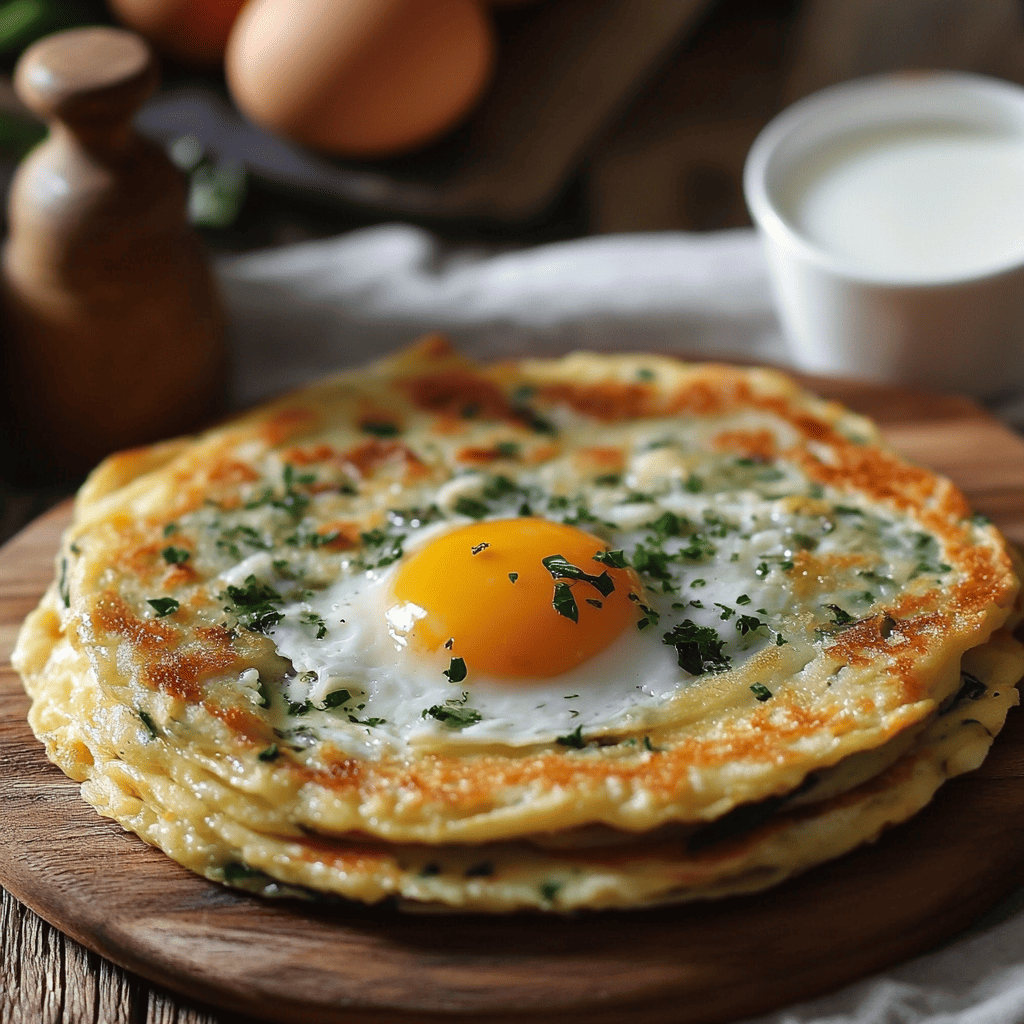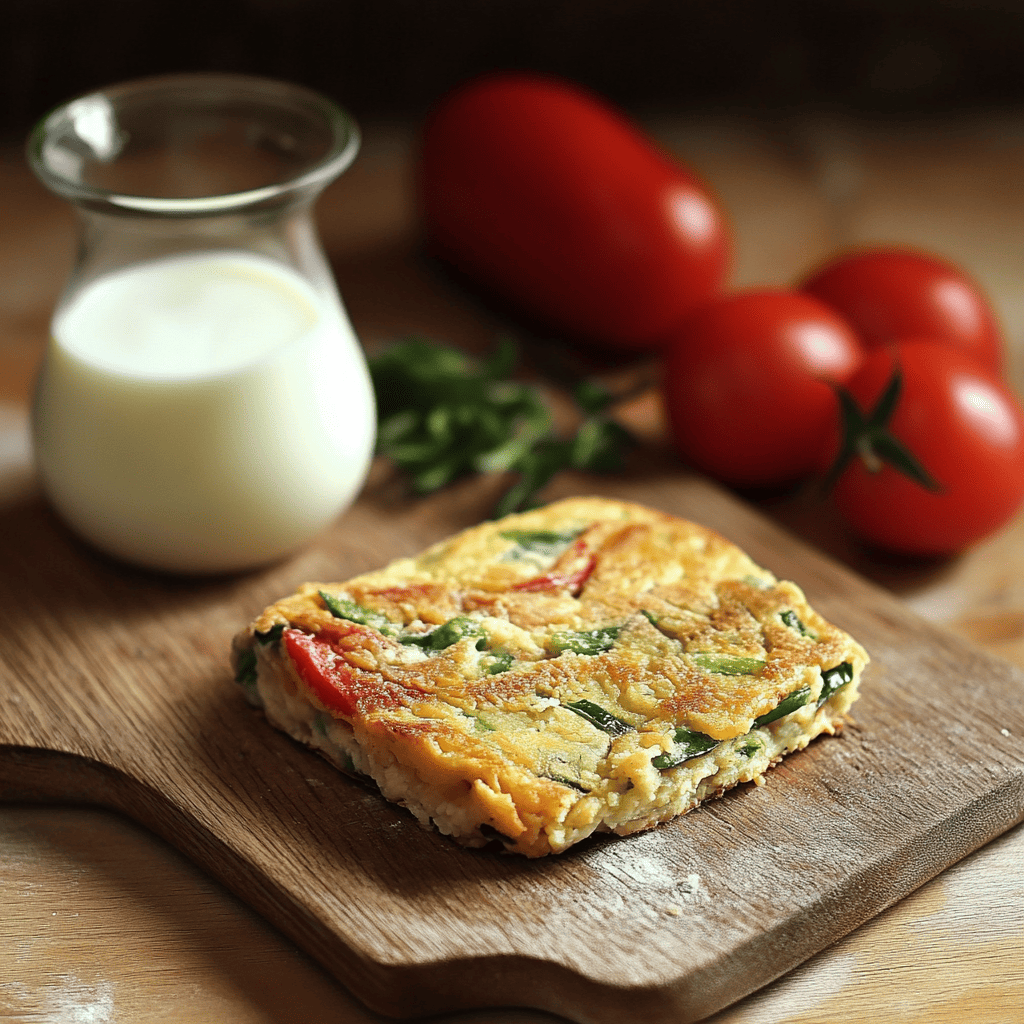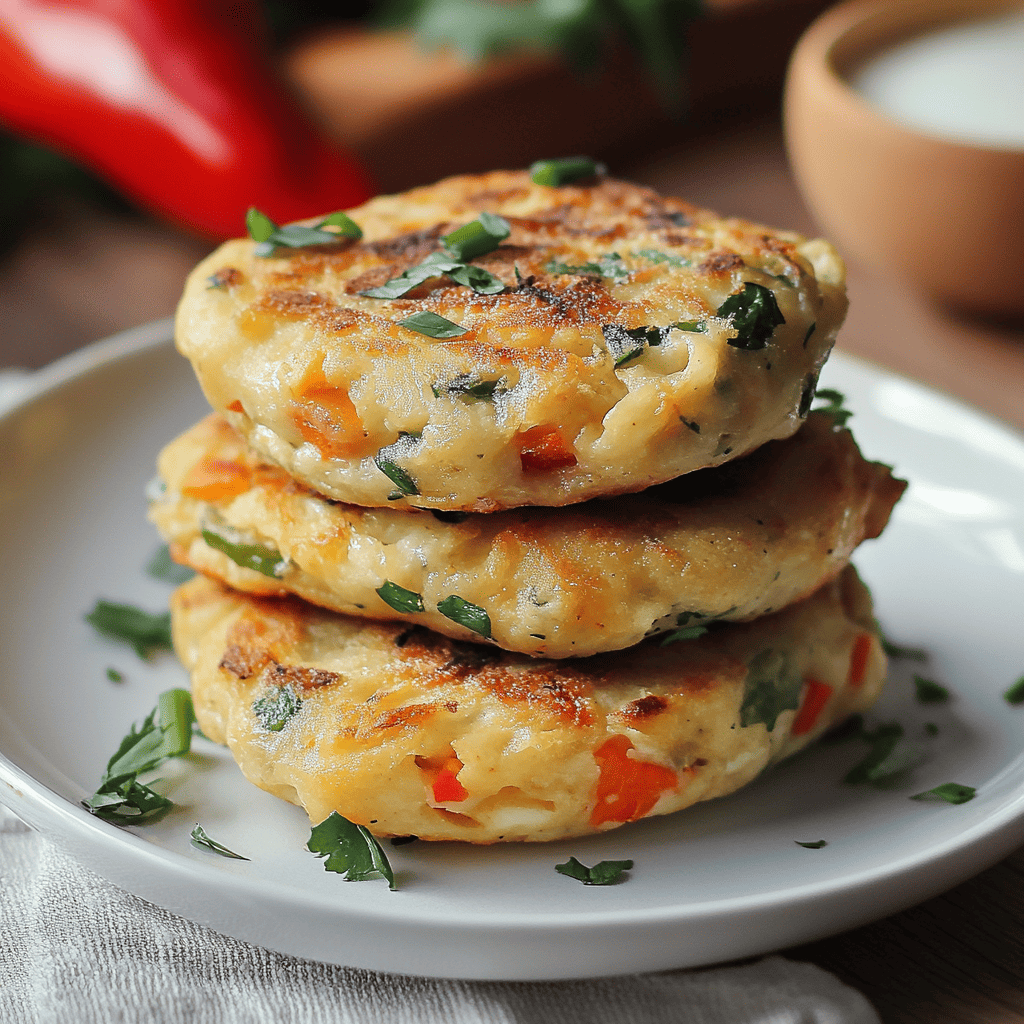Healthy Vegetable Pancakes: A Delicious and Nutritious Option for Anytime
Introduction
Healthy vegetable pancakes represent an ingenious and delicious way to incorporate essential nutrients into our daily diet. This recipe combines the simplicity of homemade pancakes with the nutritional value of grated carrots and zucchini, offering a tasty and versatile alternative to more conventional options. The egg, milk, and flour base is enriched with the juiciness and subtle sweetness of the vegetables, creating a smooth texture and a slightly sweet and earthy flavor. The addition of olive oil not only makes cooking easier but also provides healthy fats. Seasoned with salt and black pepper, these pancakes can be enjoyed alone or as a base for a variety of fillings, from creamy cheese to shredded chicken. They’re a great way to get kids (and adults) eating vegetables in a tasty and fun way. Their quick preparation makes them an ideal solution for nutritious breakfasts, light lunches, or original dinners. Get ready to discover a new way to enjoy vegetables!
A Detailed History of Pancakes and the Incorporation of Vegetables
The history of pancakes is as varied as the cultures that have adopted them. From ancient civilizations that prepared flat cakes with flours and liquids, to the elaborate creations of modern cuisine, pancakes have been a versatile food staple around the world. In ancient Greece, they were known as tagenitas, made with wheat flour, olive oil, and honey. The Romans enjoyed something similar called alita dolcia, and during the Middle Ages, pancakes became a tradition at many European festivities.
The idea of incorporating vegetables into pancakes is a more contemporary adaptation, driven by growing awareness of the importance of a plant-based diet. The search for creative and tasty ways to increase vegetable consumption has led to their inclusion in a variety of dishes, and pancakes are no exception.
Carrots and zucchini, in particular, are versatile vegetables that are easily incorporated into doughs thanks to their grated texture and mild flavor. The use of carrots in sweet and savory dishes has a long history in many cultures, appreciated for their natural sweetness and beta-carotene content. Zucchini, native to the Americas, became popular in Europe and is used in a wide range of dishes for its tender texture and delicate flavor.
The combination of these vegetables in pancakes likely arose as a way to offer a nutritious and appetizing option, especially for those looking to increase their vegetable intake without sacrificing flavor. The grated texture of the carrot and zucchini blends evenly into the batter, providing moisture and a slight sweetness that complements the other ingredients. The addition of fine herbs or grated cheese, as suggested in the recipe, reflects the versatility of these pancakes to suit different tastes and culinary preferences.
The popularity of healthy vegetable pancakes has grown in recent years, driven by trends toward more conscious eating and the search for nutritious alternatives to traditional dishes. Their simplicity and quick preparation make them an attractive option for people with busy lifestyles who don’t want to compromise their health. Plus, they’re an excellent way to use up leftover vegetables, reducing food waste. The versatility of this recipe allows for experimentation with different types of vegetables and seasonings, opening up a world of healthy and delicious culinary possibilities.

Detailed Ingredients and Step-by-Step Preparation with Additional Tips
Detailed Ingredients:
- Egg: 1 large egg . The egg acts as a binder, uniting the ingredients and providing structure and richness to the pancakes. It also provides protein and healthy fats. It’s best to use an egg at room temperature for better incorporation.
- Milk: 1/2 cup (approximately 120 ml) . Milk provides moisture to the dough, helping to achieve a smooth consistency and making it easier to mix the dry ingredients. Cow’s milk or any plant-based alternative (almond, soy, oat, etc.) can be used, depending on your dietary preferences.
- Wheat Flour: 1/2 cup (approximately 60 grams) . Wheat flour is the base of the batter, providing structure and body to the pancakes. For a healthier option, you can use whole-wheat flour or a flour blend.
- Olive Oil: 1 tablespoon (approximately 15 ml) . Olive oil not only helps create a soft dough, but also provides healthy fats and a light, distinctive flavor. Extra virgin olive oil is recommended for its nutritional benefits and flavor.
- Grated Carrot: 1/2 medium (approximately 50 grams) . Grated carrots add subtle sweetness, moisture, and a touch of color to pancakes. They’re also an excellent source of beta-carotene (provitamin A) and fiber. Grating carrots finely ensures even cooking.
- Grated Zucchini: ½ medium zucchini (approximately 75 grams) . Grated zucchini adds moisture and a tender texture to pancakes. Its mild flavor blends well with other ingredients. It’s important to grate the zucchini and, if it’s very watery, squeeze it out lightly before adding it to the batter to prevent the pancakes from becoming too soggy.
- Salt: To taste . Salt enhances the flavors of all the ingredients. Adding a pinch to the dough helps balance the sweetness of the vegetables.
- Ground Black Pepper: To taste . Black pepper adds a spicy, aromatic touch that complements the vegetables. Using freshly ground pepper provides a more intense flavor.
- Baking Powder (Optional): 1 teaspoon (approximately 5 grams) . Baking powder helps make pancakes fluffier by generating carbon dioxide during baking. If you prefer denser pancakes, you can omit this ingredient.
- Additional Cooking Oil: A splash to grease the pan . You can use the same olive oil or any other cooking oil of your choice to prevent the pancakes from sticking to the pan.
Detailed Step-by-Step Preparation:
- Wet Ingredients Mixture: In a medium bowl, crack the egg and beat it lightly with a fork or whisk. Add the milk and olive oil and mix until well combined.
- Adding Dry Ingredients: Add the wheat flour and, if desired, the baking powder to the bowl with the wet ingredients. Mix with a spoon or spatula until you have a smooth, lump-free batter. Don’t overmix, as this can develop the gluten in the flour and make the pancakes tough.
- Add the Vegetables: Add the grated carrot and grated zucchini to the batter. Mix gently until the vegetables are evenly distributed. If the zucchini has released a lot of water, be sure to squeeze it out lightly before adding it.
- Seasoning: Season the dough with salt and black pepper to taste. Mix gently to incorporate the seasonings evenly. You can taste a small portion of the dough (if you’re not worried about raw egg) to adjust the seasoning.
- Heat the Pan: Heat a nonstick skillet over low-medium heat. Grease the pan with a little oil. It’s important that the pan isn’t too hot to prevent the pancakes from burning on the outside and remaining raw on the inside.
- Cooking the Pancakes: Spoon small portions of the batter into the hot skillet (about 1/4 cup per pancake), spreading them lightly with the back of a spoon if necessary to form evenly sized circles.
- Brown on One Side: Cook the pancakes over low heat until the bottom is golden brown and small bubbles appear on the surface (about 2-3 minutes). This indicates the pancake is ready to be flipped.
- Brown the Other Side: Using a spatula, carefully flip the pancakes and cook the other side until golden brown (about 1-2 minutes). Make sure they’re cooked through by gently pressing down with the spatula; they should feel firm.
- Remove and Serve: Remove the cooked pancakes from the pan and place them on a plate. Repeat the process with the remaining batter, greasing the pan with a little more oil if necessary between batches. Serve the pancakes warm, plain or with your favorite fillings.
Additional Tips:
- Variety of Vegetables: Experiment by adding other grated vegetables such as onion, bell pepper, or finely chopped spinach to vary the flavor and nutritional value.
- Herbs: Add chopped herbs such as parsley, chives, cilantro, or dill to the dough for a touch of freshness and additional flavor.
- Shredded Cheese: Add shredded cheese (cheddar, parmesan, mozzarella) to the dough for a richer flavor and a slightly different texture.
- Spices: Try other spices like cumin, paprika, or curry powder to give your pancakes a different flavor.
- Gluten-Free Dough: For a gluten-free option, use rice flour, almond flour, or a gluten-free flour blend instead of wheat flour.
- Vegan Options: For a vegan version, replace the egg with 1 tablespoon of ground chia or flax seeds mixed with 3 tablespoons of water (let sit for 5 minutes before using) and use plant-based milk.
- Advance Preparation: The dough can be prepared up to one hour in advance and stored in the refrigerator. Stir gently before cooking.
- Keep Warm: If you’re making a large batch of pancakes, you can keep them warm in a preheated oven at a low temperature (around 100°C) while you finish cooking the rest.

Frequently Asked Questions and Estimated Preparation Time
- Can I use other vegetables? Absolutely! Try grated beets for a vibrant color and earthy, sweet flavor, or finely chopped broccoli for a touch of crunch.
- Can these pancakes be frozen? Yes, once cooked and completely cooled, you can freeze them in airtight bags or freezer-safe containers for up to 3 months. To reheat, thaw them in the refrigerator and then heat them in a skillet, oven, or toaster.
- How do I prevent pancakes from being too soggy? Make sure to grate your vegetables finely, and if they’re very watery, like zucchini, squeeze them lightly before adding them to the batter.
- Can I make them fluffier without yeast? Beating the egg separately until foamy and gently folding it into the batter can help achieve a lighter texture.
- What fillings can I use? The options are endless: cream cheese, avocado, smoked salmon, shredded chicken, hummus, or even a dollop of herbed Greek yogurt.
- Are they kid-friendly? Definitely! They’re a great way to introduce vegetables into children’s diets in a fun and tasty way. You can cut them into interesting shapes to make them even more appealing.
Estimated Preparation Time:
- Preparation of Ingredients (including grating vegetables): 10-15 minutes
- Dough Preparation: 5 minutes
- Cooking time per batch (approximately 3-4 pancakes per batch): 5-7 minutes
Estimated Total Time: 20-27 minutes
Texture and Flavor
The texture of these vegetable pancakes is soft and slightly moist thanks to the addition of grated carrots and zucchini. The wheat flour provides a tender base, while baking powder (if used) adds a touch of fluffiness . The thinly sliced vegetables add a subtle, pleasing texture to every bite.
The flavor is a delicious combination of the softness of the dough with the earthy, light sweetness of the carrot and the delicate, fresh flavor of the zucchini . The olive oil adds a subtle, fruity touch . The salt and pepper enhance the natural flavors of the vegetables, creating a pleasant balance. The addition of fine herbs or grated cheese can intensify and vary the flavor profile according to preference.
Consumer Context
Healthy vegetable pancakes are incredibly versatile and adapt to different times of the day:
- Nutritious Breakfast: A great way to start the day with a dose of vegetables and protein.
- Light Lunch: They can be enjoyed alone or accompanied by a salad for a light and nutritious meal.
- Original Dinner: Serves as a base for more substantial fillings like shredded chicken or cheese for a tasty dinner.
- Healthy Appetizer: Cut into small portions, they make an excellent appetizer for parties or gatherings.
- Baby and Toddler Food: Their soft texture and mild flavor make them ideal for introducing vegetables into little ones’ diets.
- On-the-Go Option: These can be prepared in advance and taken as a healthy snack to work or school.
Visual Aspect
Healthy vegetable pancakes have a light golden color with small orange and green dots from the grated carrots and zucchini. Their round, slightly irregular shape gives them a homemade and appetizing appearance. Served on a plate, they look fresh and colorful, especially when accompanied by fresh ingredients like sliced avocado or herbs.
Nutritional Value (Estimated per Serving)
Nutritional value may vary depending on serving size and the specific ingredients used. The following is a rough estimate for a medium pancake:
- Calories: 80-120 kcal
- Protein: 4-6 g
- Fats: 4-6 g (mainly healthy fats from olive oil)
- Carbohydrates: 8-12 g (including fiber from vegetables)
- Fiber: 1-2 g
- Vitamins and Minerals: They provide vitamins A (beta-carotene), C and K, as well as potassium and other micronutrients present in vegetables and eggs.
Additional Benefits and Interesting Facts
- Increased Vegetable Intake: A delicious and easy way to incorporate more vegetables into your daily diet.
- Source of Fiber: The fiber present in vegetables and whole wheat flour (if used) aids digestion and promotes a feeling of satiety.
- Vitamin and Mineral Contribution: Vegetables provide a variety of vitamins and minerals essential for health.
- Low in Refined Carbohydrates: By using less flour compared to traditional pancakes, they are a more balanced option.
- Versatile and Adaptable: The recipe can be easily adapted to different tastes and dietary needs.
- Great for Using Leftovers: A creative way to use up vegetables you have in the refrigerator.
- Suitable for Different Meals: They can be enjoyed for breakfast,

Conclusion
In conclusion, healthy vegetable pancakes represent a smart and delicious culinary alternative for incorporating essential nutrients into our daily diet. We’ve explored their humble history, their versatile preparation, and the many health benefits they provide. Their soft texture and subtly sweet and earthy flavor make them a delicious option for people of all ages.
From a nutritious breakfast to a light and original dinner , these pancakes adapt to a variety of eating situations, offering a creative and tasty way to enjoy vegetables. Their colorful and appetizing appearance makes them even more appealing, especially to the little ones in the house.
We’ve highlighted its nutritional value , providing fiber, vitamins, and minerals important for the body. Furthermore, its versatility allows you to experiment with different types of vegetables, herbs, and spices, opening up a world of healthy and delicious culinary possibilities.
In short, healthy vegetable pancakes are a practical, nutritious, and delicious option that proves that eating healthy doesn’t have to be boring. Go ahead and try this recipe and discover a new way to enjoy the benefits of vegetables on your table!

